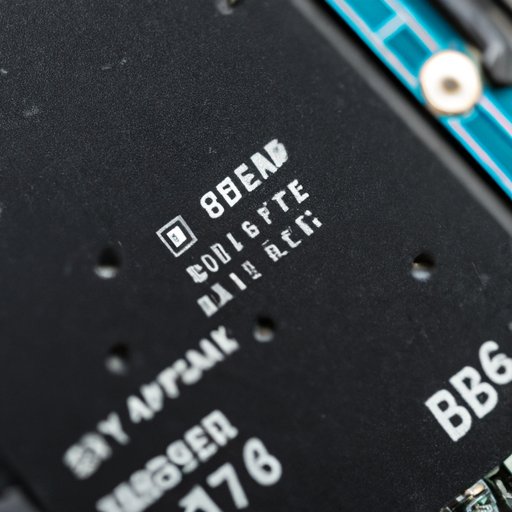Introduction
The BIOS is a firmware that is the first code to run when you turn on your computer. It initializes and tests hardware components, loads the operating system, and controls system settings. A BIOS update can improve system stability, compatibility, and security, especially for newer hardware or operating systems.
There are several reasons why you might need to update or reflash the BIOS:
- To fix bugs and issues
- To support new hardware devices or peripherals
- To enable new features or functionality
- To improve performance and efficiency
- To address security vulnerabilities or firmware exploits
The Consequences of Updating BIOS: How To Reflash
Updating the BIOS carries some risks as well. For example, if there is a power failure, or if the update process is interrupted, it could corrupt the BIOS and cause the computer to fail to boot. That is why it is important to follow the manufacturer’s instructions carefully.
On the other hand, there are also benefits to updating the BIOS:
- Better system stability and reliability
- Improved performance and efficiency
- New features or functions
- Compatibility with new hardware or software
- Security enhancements to firmware or BIOS
The consequences of failing to update the BIOS could be serious too. For example, if a hardware device is not recognized or supported, it could cause crashes or errors. In some cases, security vulnerabilities or exploits may exist in the firmware that could be exploited by attackers.
Reflashing the BIOS can help solve some of these problems and get your computer back up and running. However, it is important to be cautious and follow best practices to avoid further complications.
Troubleshooting BIOS Failure: Reflashing Your Way Out
Updating the BIOS can sometimes cause issues or errors. These can include:
- The computer fails to boot or crashes
- The BIOS update fails or hangs in the middle
- The system shows errors or warnings during the update process
- The computer overheats or becomes unstable after the update
To troubleshoot these issues, try these common solutions:
- Clear the CMOS memory by removing the battery or jumper
- Reset the BIOS settings to default values
- Try to boot from a recovery disk or USB drive
- Disable any antivirus software or firewall before the BIOS update
You may also need to reflash the BIOS itself to fix problems. This involves removing the current firmware and installing a new version. However, this process can also be risky and may require specialized tools or software.
Reflashing the BIOS can help solve some of these problems and get your computer back up and running. However, it is important to be cautious and follow best practices to avoid further complications.
A Step-by-Step Guide to Reflashing BIOS
If you decide to update or reflash the BIOS, here is a step-by-step guide to the process:
- Access the BIOS firmware settings by pressing the appropriate key during boot (usually F2 or Delete).
- Identify the current version of the BIOS and write it down.
- Download the latest version of the BIOS firmware from the manufacturer’s website.
- Create a bootable USB drive or CD/DVD with the BIOS update and any associated software or drivers.
- Insert the USB drive or CD/DVD into the computer and reboot.
- From the boot menu, select the USB drive or CD/DVD to boot from.
- Launch the BIOS update application and follow the prompts to install the new firmware.
- Wait for the update to complete and then reboot the computer.
- Test the BIOS update by checking for any errors or issues.
Tips for Safe BIOS Reflashing on Different Computers
To avoid complications and ensure a safe BIOS update, consider these tips:
- Read the manufacturer’s instructions and any release notes before updating the BIOS.
- Use a reliable and trustworthy source to download the BIOS update, such as the manufacturer’s own website.
- Backup important files and data before updating the BIOS.
- Ensure that the computer is connected to a stable power source and does not lose power during the update.
- Do not interrupt the BIOS update once it has started.
Also, note that BIOS updates can vary depending on the computer’s make and model. Some manufacturers may provide tools or utilities to automate the process, while others may require manual steps or configurations.
Reflashing BIOS: Common Dos and Don’ts for a Successful BIOS Update
Here are some common dos and don’ts for a successful BIOS update:
- Do read the release notes and any instructions before updating the BIOS.
- Do use recommended tools or software for updating the BIOS.
- Do backup important files and data beforehand.
- Do ensure that the computer is connected to a reliable power source.
- Do not interrupt the BIOS update once it has started, or turn off the computer during the update process.
- Do not install third-party software or device drivers during the update process.
- Do not update the BIOS if there is no specific reason or need to do so.
Conclusion
Updating the BIOS can be a necessary step to maintain the functionality and security of your computer. However, it can also be a risky process if not done correctly. By following the manufacturer’s instructions and best practices, you can safely update the BIOS and avoid potential complications.
To recap, we have covered the risks and benefits of updating BIOS, how to troubleshoot common problems, and provided a step-by-step guide to a safe and successful BIOS update. Remember to always backup your data, and to be cautious when updating the BIOS.
